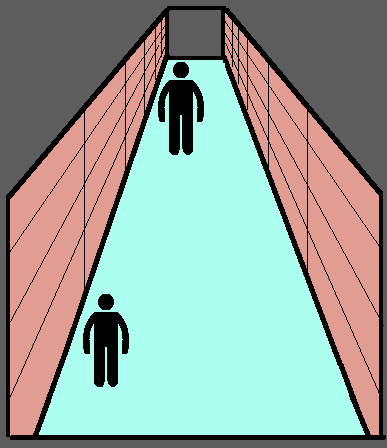Deception
Depth Perception Is Affected by Body Orientation
Your body orientation determines how near or far objects appear to be.
Posted January 30, 2022 Reviewed by Abigail Fagan
Key points
- How we determine the size of objects in our environment depends on our estimates of depth and distance.
- New research using virtual reality had participants lying face up or face down while judging the size of a virtual rod.
- Results show that participants underestimate the size of virtual objects when lying in either position compared to upright viewing.
- This study adds to growing evidence that visual perception is not isolated but integrates information from other sensory modalities.
Our perception of how large or small things are in the world is systematically influenced for how we perceive distance or depth. This is most famously shown by the Ponzo Illusion (discovered by Mario Ponzo in 1911) and studied in countless followup experiments.

In the diagram above, the person on the top part of the image appears larger than the one on the bottom, even though they are the same size. The cues in the image that signal depth, such as the perspective cues provided by the converging lines and the placement of one person higher in the visual field than the other, work together to suggest that the top person is farther away than the bottom one. This, in turn, leads us to perceive the top person as larger than the bottom one. Since we know objects look smaller as they get farther away, our visual system accounts for this and determines that the person on top must in fact be larger than the person on the bottom.
The influence of the observer's body orientation
A new virtual reality study conducted by Kim, McManus, and Harris (2021) examined whether the orientation of the observer's body could have an inlfuence on these judgments. The majority of studies examining perception of depth and size have relied on data from upright observers, typically sitting on a chair and observing stimuli on an upright screen. However, there is growing evidence that our perception changes when our bodies are in non-upright positions. For example, studies from my own lab have shown that when observers lie sideways they perceive orientation cues differently when judging faces (Davidenko & Flusberg, 2012), telling time on clocks (Davidenko et al., 2018), and reading words (Davidenko & Ambard, 2018). Furthermore, when participants lie prone (i.e. face down) or supine (i.e. face up), their judgements of motion and acceleration are systematically affected (McManus & Harris, 2021).
In the new study by Kim and colleagues, participants either sat upright or lied supine (face up) or prone (face down) while completing a size estimation task in a virtual reality environment. They held on to a reference rod measuring 45 cm and judged whether a variable-length rod shown in the virtual environment was larger or smaller than the one they were holding. Using a staircase procedure, the researchers estimated the size the virtual rod needed to be in order to be perceived as the same size as the reference rod.
A systematic bias to perceive virtual objects as closer and smaller
Overall, Kim and colleagues found that participants tended to overestimate the size of the virtual rod across all conditions. This is likely due to the fact that distance cues in virtual reality are not as compelling as distance cues in reality. If the virtual rod appears closer than it really is, then participants should adjust it to be larger in order to match the reference rod.
Regarding the role of body orientation, participants' overestimation of the length of the virtual rod was systematically larger when they were lying down compared to sitting upright, regardless of the particular direction of their bodies. When participants lay supine, they adjusted the virtual rod to be about 18.9% larger than the reference rod; when they lay prone, they adjusted the virtual rod to be about 23.6% larger than the reference rod. This bias was much larger compared to the condition in which participants sat upright, in which they adjusted the virtual rod to be only about 13.5% larger than the reference rod.
As the authors argue, the difference in size judgements as a function of body orientation could be due to at least two different mechanisms: it could be that objects simply appear smaller when we are lying down; or it could be that objects appear closer when we are lying down, and in turn we judge them to be smaller.
Based on previous work by the authors, it seems that the second explanation is more likely. Our judgments of distance and depth are based on multisensory cues, including vesitbular cues that tell us about our own motion and acceleration. McManus & Harris, 2021 had previously shown that when we lie supine we make systematic errors in judging our own movement velocity, consistent with the feeling that we are moving slower than the visual cues would suggest. Therefore it is likely that the vestibular cues associated with lying supine or prone confuse our judgemnts of self motion and in turn recalibrate our judgments of distance such that objects appear closer, and therefore smaller, than they actually are.
The study by Kim and colleagues has interesting implications for perception in virtual reality, as well as for perception in reality. As head-mounted displays become more ubiquitous, users may find themselves watching movies or playing videogames in different body positions, including lying sideways, supine, or prone. VR developers might adjust the distance cues presented under these different body positions in order to counteract the effects of our body orientation on distance and size judgments. Furthermore, there are real-life scenarios where our bodies are not upright. As Kim and colleagues noted, "Many people work in an environment where they need to be in an unusual body orientation—such as working under a car, underwater, or in space where the vestibular sense is compromised; therefore understanding the effect of body posture on size perception is an important concern."
Studies such as these contribute to a growing literature that visual perception is not determined merely by the information that enters our eyes, but it also incorporates bodily cues related to orientation, motion, and acceleration. Even the most basic processes of visual perception, like determining the size and distance of objects in our environment, are affected by the orientation of our body.
References
Kim, J. J. J., McManus, M. E., & Harris, L. R. (2021). Body Orientation Affects the Perceived Size of Objects. Perception, 03010066211065673.
Davidenko, N., & Flusberg, S. (2012). Environmental inversion effects in face perception. Cognition, 123(3), 442-447.
Davidenko, N., Cheong, Y., Waterman, A., Smith, J., Anderson, B., & Harmon, S. (2018). The influence of visual and vestibular orientation cues in a clock reading task. Consciousness and Cognition, 64, 196-206.
Davidenko, N., & Ambard, A. (2018). Reading sideways: effects of egocentric and environmental orientation in a lexical decision task. Vision Research, 153, 7-12.
McManus, M., & Harris, L. R. (2021). When gravity is not where it should be: How perceived orientation affects visual self-motion processing. Plos one, 16(1), e0243381.


